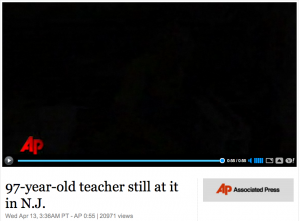In the 2011 State of the Union address, President Obama said, “nearly half of all new jobs will require education that goes beyond a high school education.” But in a recent survey, most 18-24 year olds gave their high school a low grade for preparing them for the transition to college. A majority said their school didn’t help them find a field of interest to study, help them find the college or vocational school with the right fit, or assist with financial aid.
10 common mistakes to check before turning in your final paper

Finals are just around the corner for many students, so blogger Jenn Wagner of CollegeCandy.com compiled a checklist for students to use before turning in their final paper. Wagner shares the top ten grammatical and paper writing mistakes students often overlook, and that ultimately separate them from earning an A.
1. Â No thesis statement. A thesis statement vocalizes the reason you are writing the paper. Without it there is no focus, and that means there is no paper. Don’t be afraid to adjust your thesis when you’re finished. You may have found holes in your argument or that you didn’t truly believe what you set out to prove. A revised thesis is better than no thesis at all.
2. Confusing their/there/they’re.
- They’re is a contraction that is used in place of “they are.”
- There represents a place.
- Their shows possession.
Even if you’re rolling your eyes because you are proud to already know the difference between they’re, their, and there, it’s an easy mistake to make when your furiously typing your paper at the last minute. Check that all forms of the word are correctly used when editing.
3. Not proving your point. Make sure that the body of your paper supports your opening thesis statement. All of your information in your paper should be relevant in relation to your thesis.
4. Confusing affect and effect.
- Affect – when actions are affecting someone
- Effect – the effects of a situation
Even if you are a pro at using the right effect/affect, double-check every use of them in your paper when editing.
5. Not using transition sentences. When moving from one paragraph to the next, make sure you’ve closed the first paragraph and segued smoothly into the next. You can find lists of transition words (however, nonetheless, on the contrary) that are helpful when you’re looking for the best way to move on.
6. Using the wrong than/then.
- Then – Used in a sentence when talking about time or the order things happened.
- Than – Used in a sentence when comparing and contrasting.
7. Using personal pronouns. Never use I, Me, We, We’re in a formal paper. Unless otherwise noted by your teacher, the voice of your paper should be of someone relaying information, not of you sharing your opinion.
8. Using double negatives. Never use more than one negative in a sentence.
RIGHT: I haven’t seen anyone yet.
WRONG: I haven’t seen nobody yet.
9. Not citing your sources. The rules vary depending on what style formatting your teacher requires for your class (MLA, APA). If you don’t cite your sources, you’re using someone else’s words as your own and it’s considered plagiarism. Always create your works cited page as you write your paper, so you aren’t left scrambling to piece one together at the last minute.
10. Its versus It’s.
- Its – Represents the possession of something.
- It’s – Represents “it is” or “it has.”
Before handing in your final paper, check it against these common mistakes. If some of the points on this checklist don’t apply to you, make a checklist of your personal common paper writing mistakes you know you should look for. If you’re having trouble coming up with some of your common mistakes, look back through your papers from past semesters and check for patterns in the notes your teachers have left you.
References:
How to Get an A on Your Final Paper -Â http://collegecandy.com/2011/04/12/how-to-get-an-a-on-your-final-paper/#idc-cover
Researchers find most online learners will do anything before asking for help

Ed Week writer Sarah Sparks gives the example that if you ask a friend to meet you at a new restaurant they could use a variety of tools to get there, like looking at a map, getting directions, or plugging the address into their GPS. But you wouldn’t expect them to go to every door on the block at random, give up, and then go home.
Research from Carnegie Mellon University found that many students who take online courses will typically do anything before they would consider asking for help with a problem. Online programs pose new questions that are otherwise easily addressed in a physical classroom setting. When students have a question they raise their hand or a teacher recognizes they are struggling. But with online learning, students will sit and struggle with a problem and no one ever intervenes.
Computer programs proved to be helpful in identifying weaknesses in online learning because they are able to record how many times a student tries to solve a problem, use a dictionary, or ask for help. Research shows only twenty-five percent of students will ask for help after getting a question wrong. “Seventy-five percent of them will try again. And the pattern persists after any consecutive number of errors; after five, six, attempts, I am still more likely to try again than ask for help, ” says researcher Ido Roll. Researchers also found the eighty-two percent of students who used the hint tool after struggling for an answer did not stop to read it, but clicked through until the had enough hints to guess the right answer.
But there might be a solution. Research on metacognition suggests that if students take the time to reflect on how they are learning they are more prepared to use effective learning strategies that help them learn the best. In the next experiment conducted by Mr. Roll, researchers added new hint tools to the online program that prompted students to be more reflective about problem solving and included help-windows that popped up when students clicked the hint button without enough time lapsing between hints for them to read it.
Results of the new research shows the hint-windows that encourage students to reflect on problem-solving skills decreased the number of students “gaming the system” to get through the course.
Read the full article, “Computer Tutors Prod Students to Ask for Help” at www.edweek.org/ew/articles/2011/04/14/28help.h30.html?tkn=LYMFyXXO3GmPNkgs9dT5NOADWtvR+5MO+aSV&cmp=clp-edweek
Friday Profile: Agnes Zhelesnik, the oldest teacher in the country
Agnes Zhelesnik is a preschool teacher making headline news for being the oldest teacher in the country. At 97-years-old, Zhelesnik teaches preschool at Sundance School in North Plainfield, New Jersey Monday-Friday from 8-4. She started teaching 15 years ago at the age of 82 after her husband of 61 years passed away.
Zhelesnik is known as Granny to the kids, teachers and everyone else at the school. Sundance School founder, Ginny Tobey says she believes Granny’s success at the school feeds both ways. Working with kids gives her energy and she returns the favor with love.
Watch the Associated Press’ coverage of Granny baking banana bread for her class in the video below.
Video games teach us about the educational process
Using video-game based lessons has its obvious differences from teaching with a textbook. But researcher James Gee recently looked past the digital facade of the video game to see what video games can teach us about the educational process.
Gee first looked at the process in which games are designed and how players interact with it. It’s the game-design company’s job to make a game that can be learned quickly and thoroughly. If the player doesn’t get it, they’re going to return it.
Gee compares this mentality with what most think about textbooks.
- In school, information is given to students whether they want it or not.
- You won’t need 500 pages worth of information until you finish, but by the time you get to the end you can’t remember what information was on page 2.
In a game, players get thrown in before they know all the rules or understand the territory. “Games are based on performance before competence,” says Gee. An example of this that he provides is a game that requires students to memorize 350 codes. If the students were given this task in school, they would be asked to memorize all 350 codes. With a game, the students used the codes so many times that they learned them all by the end of the game.
Another change in the educational process when compared with textbooks is that once the student has finished the game, there is no need to be tested. If they got to the end, they’ve already proven they understand and mastered the task.
Do you use video games to teach concepts in your class? Would you? Share your thoughts in the comment box below.
Student loan debt expected to top a trillion dollars
Last year was the first time student loan debt outpaced credit card debt. This year, it is expected that student debt will top a trillion dollars. These numbers show that people will be paying their loans off for a longer amount of time than they have in the past. It’s believed that a lot of people will still be paying off their student loans when it’s time for their kids to go to college, said Mark Kantrowitz, publisher of FinAid.org and Fastweb.com. Statistics show:
- Two-thirds of bachelor’s degree recipients graduated with debt in 2008, compared with less than half in 1993.
- Last year, graduates left college with an average of $24,000 in debt.
- According to the Department of Education, about a quarter of students at for-profit institutions defaulted on their student loans within three years of starting to repay them.
And the numbers aren’t expected to get any better any time soon. It’s expected that Pell grants for low-income students will be cut and tuition for public universities will continue to increase due to budget cuts.
Education policy experts are also looking at the rising debt and its implications on how the next graduating generations will buy into other large investments. People who leave college with a lot of debt may not have the option to do things like buy a home, start a family, start a business, and save for their kids’ education, says Lauren Asher, president of the Institute for Student Access and Success.
However, there are still students and experts who believe that student loans are a “healthy investment.” College Board reported those with bachelor’s degrees who worked full time in 2008 were making $55,700, which was $21,900 more than earnings of high school graduates.
What do you think? Is an average of $24,000 of debt an investment or a number that will be detrimental to the transition into the world of work?
Click here to read the New York Times article, “Burden of College Loans on Graduates Grows”
Upcoming Webinar: Promoting Summer Learning: Fostering Analytical, Practical, and Creative Intelligence
On April 19, recognized expert in student success and parent engagement, Maureen Breeze will present a live, interactive webinar entitled Promoting Summer Learning: Fostering Analytical, Practical, and Creative Intelligence.
Multitudes of research show that students experience learning losses when they are not engaged in educational learning during the summer months. According to Ron Fairchild, Executive Director of the Johns Hopkins University Center for Summer Learning:
- All students experience learning losses when they do not engage in educational activities during the summer.
- On average, students lose approximately 2.6 months of grade level equivalency in mathematical computation skills during the summer months.
- Low-income children and youth experience greater summer learning losses than their higher income peers.
- Only about 10 percent of students nationwide participate in summer school or attend schools with non-traditional calendars.
Yet many students need a break from the rigor and structure of daily school. During this webinar, LifeBound presenter, Maureen Breeze, will discuss why summer time is great for fostering multiple types of intelligence and will discuss ways you can ignite your child’s curiosity while promoting analytical, practical and creative learning.
This webinar is recommended for parents, educators, counselors, and administrators who want to improve their effectiveness with students in 5-12 grade through a summer of learning. If you are unable to make the webinar on April 19, Maureen will be presenting the same webinar live on May 10. Click on the links below to register for a session.
| Morning Session | Evening Session |
| Tuesday, April 19, 2011 | Tuesday, April 19, 2011 |
| 11:00 am – 11:45 am Eastern | 9:00 pm – 9:45 pm Eastern |
| 10:00 am – 10:45 am Central | 8:00 pm – 8:45 pm Central |
| 9:00 am – 9:45 am Mountain | 7:00 pm – 7:45 pm Mountain |
| 8:00 am – 8:45 am Pacific | 6:00 pm – 6:45 pm Pacific |
10 Guidelines for Integrating Social Media Tools into the Classroom
In a recent Edutopia blog, professor Toddy Finley offers 10 Guidelines for Integrating Social Media Tools and Spaces into the Classroom. First, to understand the skill many students have in social media, on average, kids can fit eight hours of media exposure into five hours of non-school time by media multitasking. Many teachers are aware of the media-culture their students live in and attempt to  incorporate social media into the classroom with the sole purpose of engaging students. Finley argues,  “the trick is for instructors to avoid ‘teaching’ new media tools with old media practices in their desire to engage students and teach 21st century skills.” He suggests educators to use the following guidelines, based off his own experience and extensive research, as they plan the integration of social media:
- “Imagination is heightened by rules.” Social media should be directive, but not restrictive.
- Read Michael Zimmer’s Ultimate Guide to Social Media, OnlineUniversities.com’s 100 Inspiring Ways to Use Social Media in the Classroom, and for a theoretical and practical angle, read Kristen Taylor’s How to Build an Online Community.
- Pair digital novices with digital natives to learn the how, why and when of social media.
- Glogster, Diigo, and Ning are all platforms championed originally by educators. Use these to steer clear of students’ social media territory.
- Watch social-media researcher Danah Boyd’s insightful lectures.
- Set clear distinctions between when conversational and formal writing should occur.
- Don’t require students to write “correctly” in discussion form.
- Great online discussions thrive when students and instructors trust the community.
- Don’t introduce too many different social media channels in one semester.
- Check out Quora, an online platform created and maintained by former Facebook and Google employees.
Do you have any social media guidelines you would add to the list? Share in the comment box below.
Were you one of over 10 million viewers watching the Decorah Eagle-Cam this week?
Cameras from the Raptor Resource Project made it possible for over 10 million viewers to witness three Decorah Eagles hatch in a nest 80 feet in the air all from the comfort of their computer chair. The videostream continues as the mother and father eagle care for their young and the fragile newborns get precariously close to the edge of the 1.5 ton nest.
The parents of these newborn birds have been together since the winter of 2007. They hatched 2 eaglets in 2008, 3 in 2009, and 3 more in 2010. If you you’re interested in knowing which is the male and which is the female, it’s easiest to decipher when they are in the nest together. The female is larger than the male, has a ridge around her eyes that runs further down her nose, and her eyes have a greyish shadow surrounding them.
The first hatch of 2011 was on April 2, the second on April 3, and the third on April 6. Click on the dates to watch the abridged videos of the hatching eaglets.
The Raptor Resource Project is a non-profit that specializes in preserving falcons, eagles, ospreys, hawks, and owls. You can catch the live stream 24/7 on www.ustream/tv/decoraheagles and participate in their live chat from 8am – 8pm daily.
Are you teaching your students about spring, birds of prey, family, wildlife or just need something different to show the class? Check out these videos and join in the live chat to ask experts your questions.
For more information on The Raptor Resource Project, visit www.raptorresource.org
Study: Listening to a lot of music may be an indicator of teen depression
Teenagers who spend the majority of their time listening to music are more likely to be depressed than those who spend the majority of their time reading, according to a new study. Read the rest of this entry »













